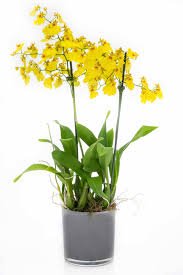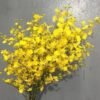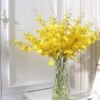**Identifying Characteristics of Oncidium Orchids**

Oncidium orchids, commonly referred to as “Dancing Lady Orchids” or “Vu Nu Orchids” in Vietnam, are renowned for their delicate, dancing flower shapes, vibrant colors, and wide-ranging adaptability. These orchids belong to the Oncidium genus, a diverse group with over 300 species that thrive in diverse climates across Central and South America. Identifying the unique characteristics of Oncidium orchids is essential for orchid enthusiasts, gardeners, and anyone interested in these captivating flowers.
This article explores the primary identification traits of Oncidium orchids, focusing on their appearance, growth habits, environmental preferences, and distinctive features that make them stand out among other orchid types.
### 1. Overview of Oncidium Orchids
The Oncidium genus, first classified by the botanist Carl Peter Thunberg in 1800, encompasses a wide array of orchid species with various forms and sizes. While some species grow epiphytically (attached to trees) in tropical rainforests, others can be found thriving in drier environments, adapting to different light and moisture levels. This adaptability has made them popular among orchid growers worldwide.
Oncidium orchids are especially loved for their “dancing” flowers that resemble fluttering skirts, hence the nickname “Dancing Lady.” Each species within the genus may exhibit unique colors, flower shapes, and foliage characteristics, but they share common identifying traits.
### 2. Physical Characteristics of Oncidium Orchids
#### a. Flowers and Color Variations
The most distinguishing feature of Oncidium orchids is their flower structure. The flowers typically have broad petals and sepals, with a large, lobed lip (labellum) that often exhibits intricate patterns or frills. This lip is often brightly colored and can appear ruffled, which contributes to the “dancing” effect as the flower moves in the breeze.
**Common Colors**:
Oncidium flowers come in a variety of colors, ranging from bright yellow and gold to orange, pink, red, brown, and even white. Yellow and gold are the most common shades, often highlighted with intricate brown or maroon markings. The contrasting colors and patterns on the petals and lip make Oncidium flowers visually striking and easy to recognize.
**Flower Size and Arrangement**:
Flower size varies greatly among species. Some Oncidium orchids have small, delicate blooms, while others produce larger, more robust flowers. The flowers are usually arranged along a long, arching inflorescence, or flower spike, that can carry dozens of blossoms at once. This feature creates a cascading effect when in full bloom, making Oncidium orchids a breathtaking sight.
#### b. Foliage and Pseudobulbs
Oncidium orchids have characteristic pseudobulbs, which are thickened stem structures that store water and nutrients. These pseudobulbs vary in shape, from elongated to round, and serve as an adaptation to withstand drier conditions. Typically, one or two leaves grow from the top of each pseudobulb, with some species producing multiple leaves.
**Leaf Texture and Shape**:
The leaves of Oncidium orchids are usually long, narrow, and leathery, with a glossy surface. The length and width of the leaves can differ among species, but they tend to be quite resilient and can vary in color from bright green to gray-green. This robust foliage allows them to withstand moderate drought conditions, making them relatively low-maintenance compared to other orchid varieties.
### 3. Growth Patterns and Habits
#### a. Epiphytic Growth
Most Oncidium species are epiphytic, meaning they grow on other plants, primarily trees, without drawing nutrients from them. Instead, they absorb moisture and nutrients from the air, rain, and decaying organic matter. This growth habit is an adaptation to their native rainforest environments, where they cling to tree branches and trunks to access sunlight in dense forest canopies.
This epiphytic nature makes Oncidium orchids well-suited for growing in pots with well-draining media or mounted on cork or bark slabs, allowing their roots to breathe and preventing root rot.
#### b. Aerial Roots
Like many epiphytic orchids, Oncidium orchids have aerial roots that play a crucial role in nutrient absorption and hydration. These roots are usually silvery-white due to a layer of velamen, a spongy tissue that absorbs water efficiently. The aerial roots are hardy and can often extend outward from the pot or mount, seeking moisture and nutrients from the air.
### 4. Flowering Patterns and Seasonal Blooming
Oncidium orchids typically bloom once or twice a year, with the blooming season varying depending on the species and growing conditions. In optimal conditions, Oncidium orchids can produce abundant blooms that last for several weeks, filling the surrounding area with their gentle fragrance and vivid colors.
Some species have a more predictable blooming season, often in the fall or winter, while others can flower intermittently throughout the year. When well-cared for, these orchids can bloom repeatedly, providing stunning floral displays for many years.
### 5. Recognizing Different Oncidium Species and Hybrids
The Oncidium genus is vast, with numerous species and hybrids exhibiting various unique characteristics. Here are some notable types and hybrids of Oncidium orchids that can help you identify specific varieties:
#### a. Oncidium Sharry Baby
One of the most popular Oncidium hybrids, Sharry Baby, is known for its chocolate-like fragrance. This hybrid produces clusters of small, reddish-brown and white flowers that exude a sweet, vanilla-chocolate scent. Sharry Baby is relatively easy to grow, making it a favorite among beginners and experienced orchid enthusiasts alike.
#### b. Oncidium Twinkle
Oncidium Twinkle is a miniature hybrid that produces small, star-shaped flowers in clusters. It is available in various colors, including white, yellow, and pink. The compact size and delicate floral scent make Oncidium Twinkle a popular choice for indoor cultivation.
#### c. Oncidium Gower Ramsey
This hybrid is famous for its bright yellow blooms with brown markings, arranged in dense clusters along tall spikes. Gower Ramsey is prized for its resilience and ease of care, making it a favorite among orchid growers worldwide.
### 6. Environmental Preferences of Oncidium Orchids
#### a. Light Requirements
Oncidium orchids thrive in bright, indirect light. They prefer filtered sunlight, similar to the dappled light found under tree canopies in their native habitats. Too much direct sunlight can cause leaf burn, while insufficient light may prevent them from blooming.
**Ideal Light Conditions**:
A windowsill with filtered sunlight or a location with morning sun exposure is ideal for Oncidium orchids. They can also thrive under artificial grow lights, especially during darker months.
#### b. Temperature and Humidity
Oncidium orchids are relatively tolerant of temperature variations, making them suitable for a range of climates. However, they generally prefer warm, humid conditions, with daytime temperatures between 70-85°F (21-29°C) and nighttime temperatures around 55-65°F (13-18°C).
**Humidity**:
High humidity, around 50-70%, is ideal for Oncidium orchids. In dry environments, a humidity tray or regular misting can help maintain optimal moisture levels. Their roots and pseudobulbs allow them to withstand occasional dry spells, but consistent humidity promotes healthier growth and more frequent blooming.
#### c. Watering Needs
Oncidium orchids require regular watering, especially during their active growing season (spring and summer). However, they are susceptible to root rot if overwatered, so it’s crucial to let the potting medium dry out slightly between waterings. The pseudobulbs store water, enabling the orchid to survive short periods of drought.
#### d. Fertilization
Feeding Oncidium orchids with a balanced, water-soluble fertilizer every two weeks during the growing season can encourage healthy growth and vibrant blooms. It is best to reduce fertilization in fall and winter, when the plant enters a dormant period.
### 7. Pests and Diseases
Oncidium orchids, like all orchids, are vulnerable to pests and diseases, which can hinder their growth and affect their blooms. Common pests include aphids, spider mites, mealybugs, and scale insects. Regular inspection and maintaining clean growing conditions can prevent infestations.
**Fungal and Bacterial Issues**:
Overwatering or poor air circulation can lead to fungal and bacterial infections, which often manifest as black spots or mold on the leaves. Promptly remove affected areas and improve airflow around the plant to prevent further issues.
### 8. Caring Tips for Long-Term Health
Oncidium orchids, with proper care, can thrive and bloom consistently year after year. Here are some long-term care tips:
– **Repotting**: Repotting every 1-2 years helps refresh the growing medium and prevents root rot.
– **Proper Airflow**: Ensure adequate ventilation to prevent fungal infections.
– **Seasonal Adjustments**: Adjust watering and light exposure based on seasonal changes to mimic natural conditions.
### Conclusion
The Oncidium or “Dancing Lady” orchid is a remarkable flower with a unique aesthetic and fascinating characteristics. Its vibrant colors, diverse forms, and captivating floral displays make it a beloved choice for orchid enthusiasts worldwide. Identifying and understanding the various aspects of Oncidium orchids — from their physical traits to their environmental preferences — enables growers to appreciate their beauty and cultivate them successfully. Whether you are a beginner or an experienced orchid grower, the Oncidium orchid promises to bring elegance and charm to any collection or garden.

